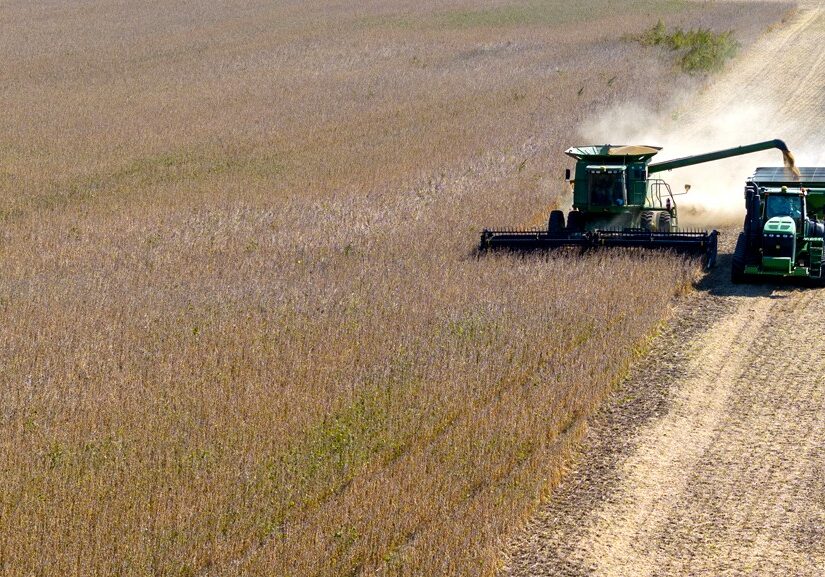What Happens When Feedlots Get Bigger in Karst Country?

PRESTON – It was a particularly frustrating day for some citizens who wanted to speak at the Fillmore County Board of Commissioner’s meeting on February 28, 2023. The board was discussing plans to raise the animal unit cap for area livestock operations from 2,000 to 4,000 — a complex issue that policy makers had to consider related to local agriculture, the region’s economy and the environment.
At the meeting, Vance Haugen, a dairy farmer from Canton Township, submitted a petition with 317 names to the board asking the county to table the feedlot expansion issue. The petition called on the board to study the potential environmental and economic impacts from raising the animal unit cap from 2,000 to 4,000.
But County Board chair Larry Hindt pre-empted any feedlot discussion by saying that the board would not be taking any additional testimony from the public on the matter as they had already received considerable comment at the Planning & Zoning Commission meeting on February 16, and through emails and phone calls.
Following 20 minutes of discussion without additional public input — which left some feeling like it had been a one-sided conversation — the Board voted unanimously to expand the animal cap on feedlots from 2,000 to 4,000 animal units.
Planning & zoning commission meeting
According to the United States Department of Agriculture (USDA), Fillmore County had 1,401 farms on 375,533 acres of land in 2017, with a combined market value of products sold at $290 million. Agriculture is an economic driver, which explains why farm and Ag related issues dominate Fillmore County government activities.
One of the goals of the Fillmore County Comprehensive Plan, adopted in 2006, is to protect the economic viability of agriculture within Fillmore County and recognize the importance of a strong livestock industry.
A companion goal is to encourage sound agricultural management practices which protect groundwater and surface water from contamination by working with agricultural operations and implementing the Fillmore County Comprehensive Water Management Plan. This includes reducing nitrate concentration in ground water and streams.
The feedlot expansion issue first came up at the Fillmore County Planning & Zoning Commission meeting on February 16, 2023. More than 100 people attended the meeting, with thirty-three of them speaking for or against expansion.
Supporters argued that feedlot operators should be allowed to expand their operations to encourage economic growth, noting that any permitting of operations with more than 1,000 animal units would be done by the Minnesota Pollution Control Agency (MPCA). They also pointed out that the county Feedlot Ordinance had been created in 1997 and was long out of date.
Opponents of the expansion believed that increasing the allowable number of animal units would have a negative environmental impact on water quality in a county dominated by Karst geology. And they were concerned about the financial impact expansion of feedlots would have on tourism and area communities.
After nearly two hours of discussion, the seven-member Commission approved the plan on a 5 to 1 vote, with one member, Trinity Johnson, recusing himself. Johnson also did not participate in any of the ongoing discussions during the meeting.
Making difficult decisions is hard enough based on facts, studies and public opinion. Friendships and conflicts of interest add another dimension. It is common knowledge that Planning Commission member Johnson, of Johnson Rolling Acres in Norway Township, had asked the Planning Commission to consider the animal unit change as their operation was thinking of expanding in the future.
Johnson Rolling Acres is one of the largest dairies in Fillmore County. It was reported in AgWeek on July 26, 2022 that the family-owned operation milks 1,200 cows and finishes 10,000 pigs per year, on 3,500 acres of land. The Minnesota Milk Producers Association named Johnson Rolling Acres 2022 Producer of the Year.
Water quality in karst country
There are more than 10,000 sinkholes of various sizes in Fillmore County. In fact, the county has more caves, sinkholes and disappearing streams than all other 86 Minnesota counties combined, which makes it susceptible to surface runoff.

There are more than 10,000 sinkholes in Fillmore County making groundwater susceptible to surface runoff. Above, spring runoff in March near Harmony. (Submitted photo)
Dye tracings have been found to travel up to 10 miles underground from a source point. Feedlot manure management plans call for the application of manure on farmlands, which creates the potential to pollute surface and ground water with nitrate.
And spills happen as well. In April 2013, a 2.2 million gallon above-ground manure storage pit failed at Soiney Farms dairy operation near Canton following heavy rains. Some of the runoff went into nearby trout streams. The pit was less than two years old.
More recently, the MPCA investigated a fish kill on Rush Creek between Lewiston and Rushford that occurred in July 2022 killing 2,500 fish, mainly brown trout. The investigation concluded that the kill-off was not natural and most likely caused by runoff from field manure application following heavy rains.
In a letter to the Fillmore County Board dated February 27, 2023, obtained by Root River Current, Joy Anderson, staff attorney for the Minnesota Center for Environmental Advocacy, cautioned the board “that doubling the animal unit cap — an action likely to increase nitrate contamination in the County’s already polluted water — could violate the Minnesota Environmental Rights Act (MERA) and subject the County to a lawsuit.”
Anderson cited a study conducted by the Minnesota Department of Agriculture in conjunction with the Fillmore Soil and Water Conservation District looking at nitrate levels in 1,417 wells in all 24 townships in Fillmore County in 2017-2018. The results showed that 17 percent of the wells had nitrate levels above the Health Risk Limit of 10 milligrams-per-liter (10 mg/l is the Environmental Protection Agency threshold for preventing Blue Baby Syndrome).
Environmental Working Group (EWG), an environmental advocacy organization, analyzed data from state water quality studies over the past 10 years.
Tests by the Minnesota Department of Health and Department of Agriculture show that 7,657 Minnesota households drink from private wells with at least one test at or above 3 mg/L of nitrate.
Data from the U.S. Environmental Protection Agency show that 472,983 Minnesotans — more than the population of Minneapolis — are served by a total of 727 public water systems that were contaminated with at least 3 mg/L of nitrate. Almost 300,000 people drink from public systems contaminated at or above 5 mg/L, and more than 150,000 from public systems with at least 10 mg/L. (EWG 2020)
This is not the first time the public has opposed a feedlot proposal in Fillmore County. In May 2018, the MPCA was asked to permit a 4,980 sow farrowing operation with a planned nine million gallon manure storage pit for Catalpa, Inc. in Newburg Township. The manure was equal to the waste of a city of 50,000 people.

In 2018, citizen’s organized opposition to a proposed sow farrowing operation planned for Canton Township by Catalpa, Inc. Above, a homemade sign opposing the Catalpa project. (Photo by Renee Bergstrom)
Opponents mobilized the area community, brought in geological experts, and submitted 772 written comments to the MPCA. Eventually the permit was denied and the application withdrawn.
The Minnesota Department of Agriculture has produced this video that shows how groundwater moves through the Karst landscape carrying contaminants with it.
A level farming playing field
The USDA has set the basic formula for determining animal units with one animal unit equaling 1,000 pounds. All livestock are measured against this metric. For example, a dairy cow over 1,000 pounds is 1.4 animal units; swine over 300 pounds is .4 animal units; etc.
The Fillmore County Feedlot Ordinance requires that any operation with more than 50 animal units must get a Feedlot Permit. Feedlots larger than 1,000 animal units need a Conditional Use Permit from the county as well as a National Pollutant Discharge Elimination System (NPDES) feedlot permit from the Minnesota Pollution Control Agency. Applicants must submit an Environmental Assessment Worksheet, and may be asked to complete an intensive and costly Environmental Impact Statement.
The NPDES requires at least nine months of liquid manure storage capacity. New liquid storage areas must have the following separation to bedrock: 40 feet for earthen liners; 15 feet for concrete liners. There is no winter application of solid manure.
According to Fillmore County Zoning Administrator Crystal Adkins nothing changes with permitting.
“Any expansion of operations would still require a Conditional Use Permit from the County Board,” Adkins said. “This would go before the Planning & Zoning Commission for a public hearing and then to the Commissioners.”
Following any county approval, expansion plans would still need to be reviewed by, and granted a permit from, the Minnesota Pollution Control Agency.
Farmers contend that once an operation exceeds the 1,000 animal unit threshold it creates a level playing field for all operators. All the rules are the same.
“There are no applications in place,” Commissioner Duane Bakke told the audience at the County Board meeting, referring to feedlot expansion plans. “There is one farm that has 1996 animal units and is close to the 2000 cap. They requested that it (feedlot ordinance) be reviewed.” Bakke, who talked for the next 15 minutes, explained that the Planning & Zoning Commission often responds to requests from the public to review ordinances, whether it is for B&Bs, wedding venues, Ag tourism or Rock Fests — in this case, feedlot expansion. Speaking to those opposed to the ordinance change, Bakke said, “You should interview all 87 counties — only 21 counties have a cap.” At that comment, one audience member yelled out, “How many counties have Karst topography?” Bakke also suggested that objections to the feedlot expansion were harmful to the economy by creating negative publicity for Fillmore County. There were few questions or comments from the other commissioners. Done with his presentation, Bakke made a motion to approve the expansion to 4,000 animal units. Commissioner Mitch Lentz, seconded it. The motion passed. After the meeting, Haugen commented that some people think because petitioners asked for a study that they are anti-farm. “I’m a farmer. We’re not anti-farm. We just don’t think farming needs to succeed at the expense of the environment or water quality. We are essentially asking the County Board to answer one question: what happens to the environment and the economy when feedlots get bigger?”
Sources:
Additional Articles On Water Quality Published By Root River Current: Minnesota Launches First Phase of Nitrate Mitigation Plan Minnesota Nitrate concerns inspire Iowa groups to seek EPA help Nitrate and Water Issue Proposals Addressed by 2024 Minnesota Legislature State Officials: January 2024 Plan Addresses Nitrate Contamination Issues Local Forums, EPA Raise Questions About SE Minnesota Water Quality … State Agencies Respond






